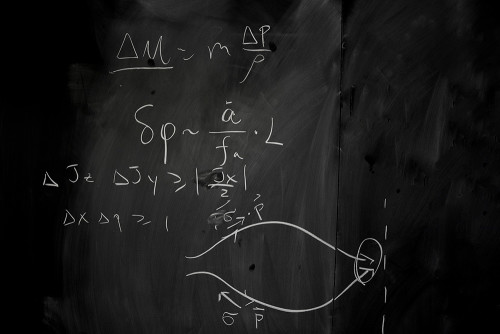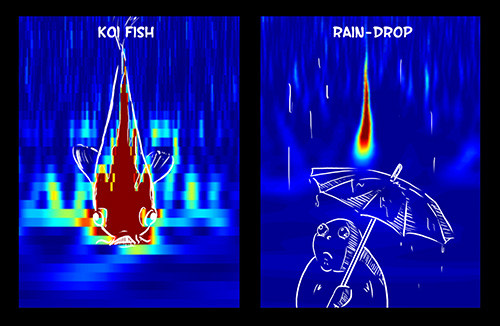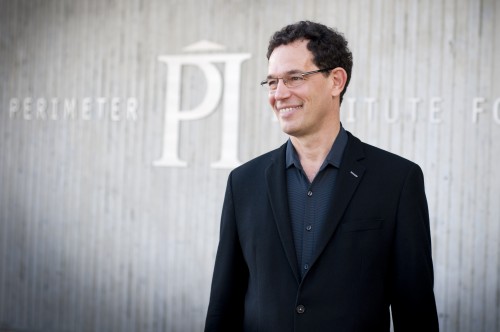Tag archives: string theory
Test your brains with the Physics World blackboard quiz
By Matin Durrani
Can you tell what branch of physics is being described on the blackboard above? It’s one of six photographs taken by the communications folks at the Perimeter Institute for Theoretical Physics in Waterloo, Canada, where blackboards are an integral feature of the building’s design, appearing everywhere from the lifts to coffee areas.
In this quiz, your task is to study six blackboards and match them up with the physics topics they represent. There’s no prize, other than the satisfaction of having at least some inkling of what those clever theorists at the Perimeter are up to.
So here are the six topics:
• Accretion physics and general relativity
• Cosmology
• Neural networks and condensed matter
• Particle physics 1
• Particle physics 2
• Strings
And here are the six blackboards (you can click on each to see it in more detail).
From blue fogs to Brexit – the April 2017 issue of Physics World is now out
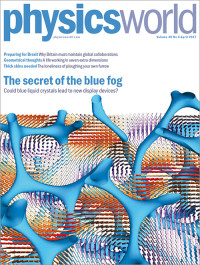 By Matin Durrani
By Matin Durrani
“The secret of the blue fog” might sound like a Tintin book, but it’s all about a strange form of liquid crystal that’s the cover story in the April 2017 issue of Physics World magazine, which is now live in the Physics World app for mobile and desktop.
First observed in the late 1800s, only recently have we finally uncovered the structure of these materials, which turn blue when cooled. As Oliver Henrich and Davide Marenduzzo explain, blue liquid crystals could be used for new kinds of display devices.
Elsewhere in the issue, mathematical physicist Jason Lotay explains his work in seven extra dimensions, while science writer Benjamin Skuse examines the challenge for respected physicists with theories outside the mainstream.
Don’t miss either our latest look at Donald Trump’s scientific shenanigans, including an interview with Rush Holt – the physicist-turned-politician who’s now head of the American Association for the Advancement of Science.
Remember that if you are a member of the Institute of Physics, you can read Physics World magazine every month via our digital apps for iOS, Android and desktop.
View all posts by this author | View this author's profile
Using pottery to communicate science

Showcasing science – one of the ceramic items created by Nadav Drukker on show at the new Quantum Ceramics exhibition in London. (Courtesy: Nadav Drukker)
By Matin Durrani
You might not think theoretical physics and pottery have much in common. But they do now, thanks to a new exhibition being staged at the Knight Webb Gallery in Brixton, south-east London, which opens today.
Entitled Quantum Ceramics, the exhibition is the first solo display of ceramic works by theoretical physicist Nadav Drukker. Based at King’s College London, Drukker makes traditional studio pottery as a new way to communicate his scientific research.
Drukker, who is a string theorist, has six different projects – entitled “Circle”, “Cusp”, “Index”, “Polygons”, “Cut” and “Defect” – with each inspired by one of his research papers. His works are all traditional glazed stoneware and porcelain vessels, but decorated with mathematical symbols.
View all posts by this author | View this author's profile
Sea monsters at LIGO, how to become a ‘thought leader’ and why not string theory?
By Hamish Johnston
Have you ever wondered how the LIGO collaboration managed to tease out the tiny signal from gravitational wave GW150914 from all the background noise in its kilometre-sized detectors? Well you’re in luck because experts from the LIGO detector characterization group have written a lively piece on the CQG+ blog called “How do we know LIGO detected gravitational waves?”.
It’s packed full of fun facts; for example, did you know that detecting GW150914 is roughly the same as measuring a change in distance the thickness of a human hair between Earth and Alpha Centauri, the closest star to Earth? But be warned, the article is also full of technical terms such as “whistles”, “blips”, “koi fish” and even “Fringey the sea monster”. These are illustrated in the above graphic by LIGO physicist and artist Nutsinee Kijbunchoo.
View all posts by this author | View this author's profile
Celebrating the centenary of Einstein’s general theory of relativity and asking what theorists have done lately
By Hamish Johnston
This week, people all over the world have been celebrating the 100th anniversary of Einstein’s general theory of relativity (GR). Einstein delivered his theory this week in November 1915. Not surprisingly, the Web has been buzzing with tributes to Einstein and explanations of his theory.
In the above video, the physicist Brian Greene and two young assistants demonstrate Einstein’s explanation of gravity using a huge piece of stretched Spandex. Why they have this Spandex ring in what appears to be their living room remains a mystery, but it and a large number of marbles do the trick when it comes to explaining GR.
Why converge?
By Louise Mayor in Waterloo, Canada
Right now, top physicists from around the world are arriving in Waterloo, Canada, to attend a unique conference. Christened Convergence, the meeting is the brainchild of Neil Turok, director of the Perimeter Institute for Theoretical Physics (PI) in Waterloo, where the event will be based. I spoke to Turok to find out what motivated him to set up this conference, what makes it so special, and what he hopes it will achieve.
The admiral of the string-theory wars, add-male-author-gate, the Einstein font and more…

Julie Peasley, creater of the Particle Zoo. (Courtesy: CERN)
By Hamish Johnston
Peter Woit is lauded by some for having the courage to speak the truth to the physics establishment, while others see him as an enemy of science. Woit writes the Not Even Wrong blog, which has the same title as a controversial book he once wrote about the merits of string theory. In an article in the latest issue of Nautilus, Bob Henderson profiles Woit and his three decades of doubt over various incarnations of the theory that culminated about 10 years ago in the “string wars”. Henderson’s article is called “The Admiral of the String Theory Wars” and provides a fascinating insight into how the rise of string theory caused Woit to switch from physics to mathematics and his relationships with string theorists – some of whom work in the same building as Woit at Columbia University.
Entangled and stringy videos, a new chat show about the heavens, Hawking and Newton hit the Oregon Trail and more
By Hamish Johnston
This week’s Red Folder begins with a pair of videos that attempt to explain some of the most difficult concepts in physics. First up is a video featuring physicist and filmmaker Derek Muller, who does a lovely job of explaining quantum entanglement with the help of a few cardboard cut-outs and a couple of spinning avatars (see above).
A 21st-century discourse on quantum mechanics and space–time
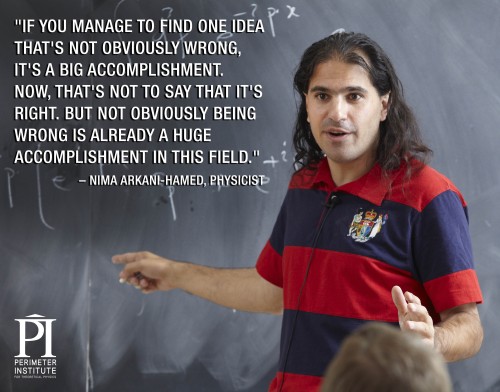
Revealing the secrets of space–time? (Courtesy: Perimeter Institute for Theoretical Physics)
By Tushna Commissariat
If you fancy a bit of late-night quantum mechanics, make sure that tonight you tune into the live webcast of “Quantum Mechanics and Spacetime in the 21st Century” – a lecture that by physicist Nima Arkani-Hamed as part of the Perimeter Institute’s Public Lecture Series. Arkani-Hamed, who won the inaugural Fundamental Physics Prize in 2012, says that he hasn’t “been this excited about physics in a very long time”. He will talk about how the most recent advances in quantum mechanics shed new light on our understanding of the universe’s fabric of time and space. In the past, Arkani-Hamed has shown how the weakness of gravity, compared with the other fundamental forces of nature, might be explained by the existence of extra dimensions of space. He has also recently been involved in the 2013 documentary Particle Fever, about the search for the Higgs boson.
The webcast will begin at 11.45 p.m. GMT (7 p.m. EST) and you can send questions to Arkani-Hamed by tweeting @Perimeter and using the hashtag #piLIVE. Take a look at a short teaser video for his talk below and tell us what you think about it in the comments section.
The pin-up of particle physics, an octopus-inspired robot and Witten versus Horgan redux
By Hamish Johnston
One of my favourite radio programmes is The Life Scientific, in which the physicist Jim Al-Khalili talks to leading scientists about their lives and work. Al-Khalili introduces this week’s guest as “the pin-up of particle physics”, whose remarkable career has taken him from playing keyboards in pop bands, to winning a Royal Society University Research Fellowship to do particle physics, to hosting one of the BBC’s most popular science programmes.
